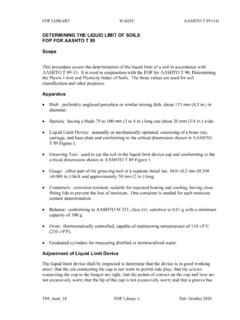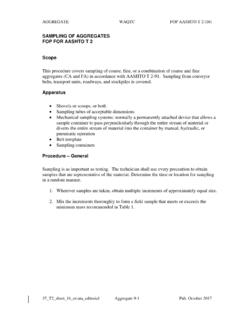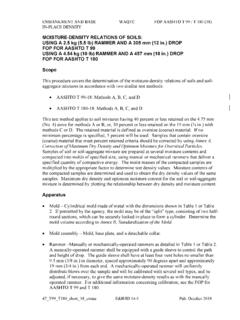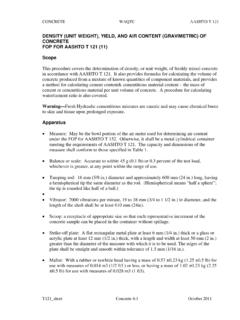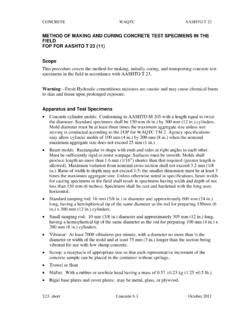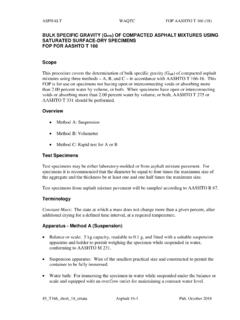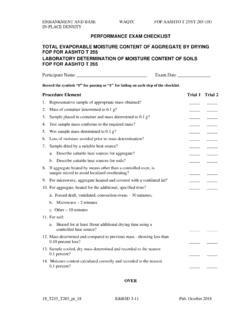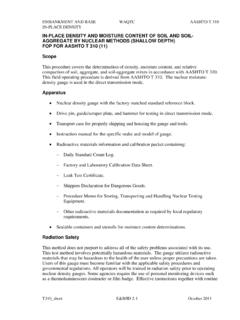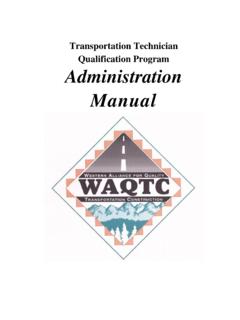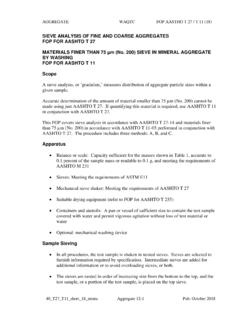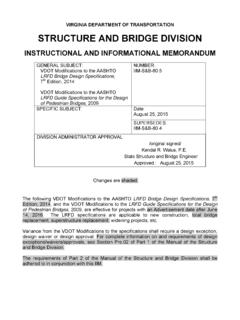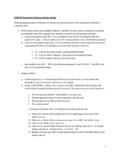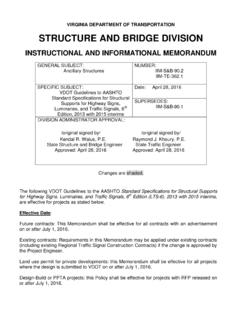Transcription of SIEVE ANALYSIS OF FINE AND COARSE AGGREGATES FOP FOR ...
1 AGGREGATE WAQTC aashto T 27/T 11 T27_T11_short Aggregate 4-1 October 2011 SIEVE ANALYSIS OF FINE AND COARSE AGGREGATES FOP FOR aashto T 27 (11) MATERIALS FINER THAN 75 m (No. 200) SIEVE IN MINERAL AGGREGATE BY WASHING FOP FOR aashto T 11 (11) Scope SIEVE ANALYSIS determines the gradation or distribution of aggregate particle sizes within a given sample. Accurate determination of material smaller than 75 m (No. 200) cannot be made with aashto T 27 alone. If quantifying this material is required, it is recommended that aashto T 27 be used in conjunction with aashto T 11. This FOP covers SIEVE ANALYSIS in accordance with aashto T 27 and materials finer than 75 m (No. 200) in accordance with aashto T 11 performed in conjunction with aashto T 27. The procedure includes three method choices: A, B, and C. Apparatus Balance or scale: Capacity sufficient for the masses shown in Table 1, accurate to percent of the sample mass or readable to g, and meeting the requirements of aashto M 231 Sieves: Meeting the requirements of aashto M 92 Mechanical SIEVE shaker: Meeting the requirements of aashto T 27 Suitable drying equipment (see FOP for aashto T 255) Containers and utensils: A pan or vessel of a size sufficient to contain the sample covered with water and to permit vigorous agitation without loss of any part of the sample or water Optional mechanical washing device Sample Sieving In all procedures, it is required to shake the sample over nested sieves.
2 Sieves are selected to furnish information required by specification. The sieves are nested in order of decreasing size from the top to the bottom and the sample, or a portion of the sample, is placed on the top SIEVE . AGGREGATE WAQTC aashto T 27/T 11 T27_T11_short Aggregate 4-2 October 2011 Sieves are shaken in a mechanical shaker for approximately 10 minutes, or the minimum time determined to provide complete separation for the SIEVE shaker being used. As established by the Time Evaluation. Time Evaluation The sieving time for each mechanical SIEVE shaker shall be checked at least annually to determine the time required for complete separation of the sample by the following method: 1. Shake the sample over nested sieves for approximately 10 minutes. 2. Provide a snug-fitting pan and cover for each SIEVE , and hold in a slightly inclined position in one hand.
3 3. Hand-shake each SIEVE by striking the side of the SIEVE sharply and with an upward motion against the heel of the other hand at the rate of about 150 times per minute, turning the SIEVE about one sixth of a revolution at intervals of about 25 strokes. If more than percent by mass of the total sample prior to sieving passes any SIEVE after one minute of continuous hand sieving adjust shaker time and re-check. In determining sieving time for SIEVE sizes larger than mm (No. 4), limit the material on the SIEVE to a single layer of particles. Overload Determination For sieves with openings smaller than mm (No. 4), the mass retained on any SIEVE shall not exceed 7 kg/m2 (4 g/in2) of sieving surface. For sieves with openings mm (No. 4) and larger, the mass, in grams shall not exceed the product of ( SIEVE opening in mm) (effective sieving area).
4 See Table 1. Additional sieves may be necessary to keep from overloading sieves or to provide other information, such as fineness modulus. The sample may also be sieved in increments to prevent overload. AGGREGATE WAQTC aashto T 27/T 11 T27_T11_short Aggregate 4-3 October 2011 TABLE 1 Maximum Allowable Mass of Material Retained on a SIEVE , g Nominal SIEVE Size, mm (in.) Exact size is smaller (see aashto T 27) Sample Preparation Obtain samples in accordance with the FOP for aashto T 2 and reduce to the size shown in Table 2 in accordance with the FOP for aashto T 248. These sample sizes are standard for aggregate testing but, due to equipment restraints, samples may need to be partitioned into several subsamples. For example, a gradation that requires 100 kg (220 lbs) of material would not fit into a large tray shaker in one batch.
5 Some agencies permit reduced sample sizes if it is proven that doing so is not detrimental to the test results. Some agencies require larger sample sizes. Check agency guidelines for required or permitted test sample sizes. SIEVE Size mm (in.) 203 dia (8) 305 dia (12) 305 by 305 (12 12) 350 by 350 (14 14) 372 by 580 (16 24) Sieving Area m2 90 (3 1/2) * 15,100 20,900 27,600 48,500 75 (3) * 12,600 17,400 23,000 40,500 63 (2 1/2) * 10,600 14,600 19,300 34,000 50 (2) 3600 8400 11,600 15,300 27,000 (1 1/2)
6 2700 6300 8700 11,500 (1) 1800 4200 5800 7700 13,500 (3/4) 1400 3200 4400 5800 10,200 (5/8) 1100 2700 3700 4900 8600 (1/2) 890 2100 2900 3800 6700 (3/8) 670 1600 2200 2900 5100 (1/4) 440 1100 1500 1900 3400 (No.)
7 4) 330 800 1100 1500 2600 (-No. 4) 200 470 650 860 1510 AGGREGATE WAQTC aashto T 27/T 11 T27_T11_short Aggregate 4-4 October 2011 TABLE 2 Sample Sizes for Aggregate Gradation Test Nominal Maximum Size* mm (in.) Minimum Dry Mass g (lb) (No. 4) 500 (1) (1/4) 1000 (2) (3/8) 1000 (2) (1/2) 2000 (4) (3/4) 5000 (11) (1) 10,000 (22) (1 1/2) 15,000 (33) 50 (2) 20,000 (44) 63 (2 1/2) 35,000 (77) 75 (3) 60,000 (130) 90 (3 1/2) 100,000 (220) 100 (4) 150,000 (330) 125 (5) 300,000 (660) *Nominal maximum size: One SIEVE larger than the first SIEVE to retain more than 10 percent of the material using an agency specified set of sieves based on cumulative percent retained.
8 Where large gaps between specification sieves exist, intermediate SIEVE (s) may be inserted to determine nominal maximum size. Selection of Procedure Agencies may specify what method will be performed. If a method is not specified method A will be performed. Overview Method A Determine dry mass of original sample Wash through a 75 m (No. 200) SIEVE Determine dry mass of washed sample SIEVE material Method B Determine dry mass of original sample Wash through a 75 m (No. 200) SIEVE Determine dry mass of washed sample SIEVE COARSE material Determine dry mass of fine material Reduce fine portion Determine mass of reduced portion SIEVE fine portion AGGREGATE WAQTC aashto T 27/T 11 T27_T11_short Aggregate 4-5 October 2011 Method C Determine dry mass of original sample SIEVE COARSE material Determine mass of fine material Reduce fine portion Determine mass of reduced portion Wash through a 75 m (No.)
9 200) SIEVE Determine dry mass of washed sample SIEVE reduced fine portion Procedure Method A 1. Dry the sample to a constant mass in accordance with the FOP for aashto T 255, and record to the nearest percent of the total sample mass or g. 2. When the specification requires that the amount of material finer than 75 m (No. 200) be determined, perform Step 3 through Step 9; otherwise, skip to Step 10. 3. Nest a SIEVE , such as a mm (No. 10), above the 75 m (No. 200) SIEVE . 4. Place the test sample in a container and add sufficient water to cover it. Note 1: A detergent, dispersing agent, or other wetting solution may be added to the water to assure a thorough separation of the material finer than the 75 m (No. 200) SIEVE from the coarser particles. There should be enough wetting agent to produce a small amount of suds when the sample is agitated.
10 Excessive suds may overflow the sieves and carry material away with them. 5. Agitate vigorously to ensure complete separation of the material finer than 75 m (No. 200) from coarser particles and bring the fine material into suspension above the coarser material. When using a mechanical washing device, exercise caution to avoid degradation of the sample. 6. Immediately pour the wash water containing the suspended and dissolved solids over the nested sieves, being careful not to pour out the coarser particles. 7. Add a second change of water to the sample remaining in the container, agitate, and repeat Step 6. Repeat the operation until the wash water is reasonably clear. If a detergent or dispersing agent is used, continue washing until the agent is removed. 8. Remove the upper SIEVE , return material retained to the washed sample.
